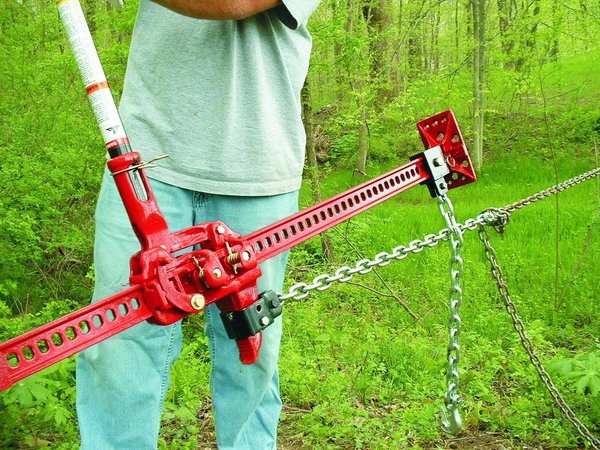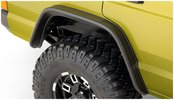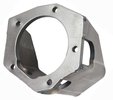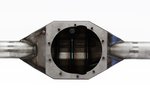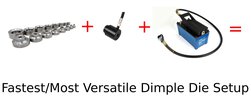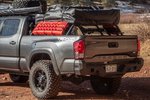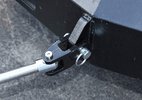Use Your Hi-Lift Jack as a Winch
What do you do if you have no money for a winch, but you have a Hi-Lift Jack?
Turn it into a winch!
Winching with your Hi-Lift is possible and easy to set up. It can save your bacon off road by pulling you out of the muck and stabilizing your rig in bad winching situations. It can even help you with heavy duty yard work at home.
Now:
The Hi-Lift Jack is not the perfect winch (it is a jack, after all), but if you need to pull or move something it'll get the job done. And it's always handy for lifting.
In this article, we'll take a look at how to use your Hi-Lift Jack as a winch and what you need to get the job done.
- The Best Hi Lift Jack Accessories
- The Hi-Lift Jack Buyer's Guide
- You're just starting out in fourwheeling and you need a cheap way to winch.
- You're familiar with recovery and want an impromptu way to self-recover your non-winched equipped rigs.
- You want to supplement your winch in advanced 4x4 recovery operation.
- Knowing your limits is good. A Hi-Lift can probably pull your high-centered Tacoma off some muddy ruts, but it won't pull your sunk F350 crew cab out of axle-deep mud.
- Your 4x4 is on wheels that roll. There's a big difference between pulling a 4000 lb block and a 4000 lb Jeep. You can stack rocks or logs and dig to make ramps to lessen the strain on your jack.
- Passengers can help drive while you man the jack handle. A little wheelspin can get you moving.
- Preparation is key. You need to be able to reach between your rig and winch anchor points and you'll probably want to supplement your winching with a shovel, saw, and/or axe.
- Winch Tensioner
- Custom Nose Attachment
- 8 ft. Tree Saver Strap
- Gloves
- Gear Bag
The winch gear attaches quickly and easily. The hanging chain near the jack base secures the jack while you reset it at the end of the bar's travel.
You already know that your Hi-Lift can lift your rig, but you can also use it to winch.
You can put some of the components you need together by yourself, but Hi-Lift also sells a Hi-Lift winch kit that does it all for you.
It's easy to turn the Hi-Lift into a winch, and it's an easy way to
make it a little more versatile. You should be familiar with the Hi-Lift
winch setup if:
Hi-Lift Winch Vs. Regular Winch
| Hi-Lift Winch | Regular Winch | |
|---|---|---|
| Setup Cost | Cheap | 1.5-2k |
| Max Weight | 5000-7000 lbs. | Usually 8000 lbs. and up |
| Speed | Slow | Fast |
| Setup time | Slow | Fast |
| Attachment | Use anywhere | Front bumper |
A regular winch is definitely better, but it's also very expensive. The Hi-Lift is a budget option that is slower and less versatile than a regular winch. With a winch you can hook up the line and press a button. With the Hi-Lift you need to put in (sometimes significant) effort to extract yourself.
A Hi-Lift winching setup is way cheaper than a normal winch, though. You probably need to invest a couple of hundred dollars to be winching with a Hi-Lift Jack. Contrast that with a winch: the winch alone will be several hundred, plus you need a winch bumper and components for an off road recovery kit. It's pretty easy to be pushing $2000 on a new winch installation.
A Hi-Lift Jack can't winch as much as most winches you're likely to buy for your rig. It's also slower and less effective for long distances.
It is very useful as a stabilizing winch that supplements your main winch. If you have to a recover a 4x4 off a slope, you often need to keep the rear end from moving downslope. Since you probably already have a Hi-Lift, a winch kit is a simple addition to your recovery bag to make stabilizing off-balance 4x4s easier.
Hi-Lift Jack Weight Ratings
The Hi-Lift is pretty safe, but can still be misused.
Pay attention to the max weight ratings. Most models have similar specs, no matter which Hi-Lift Jack you choose.
There is a primary shear bolt that's rated to 7000 lbs. If you exceed the 7000 lb. rating and the bolt breaks, the jack should maintain it's position by the use of the climbing pins. In theory, the climbing pins are rated for more than the shear bolt. This means that if you break the shear bolt while jacking or winching the jack will hold the load on the climbing pins.
At this point Hi-Lift says you should release the load using a higher rated jack or winch, but realistically speaking, you're probably going to install a new shear bolt and figure out a way not to break it in the field. It's against Hi-Lift's safety recommendations, but it's possible to replace the shear bolt with a new one from an official Hi-Lift repair kit while the climbing pins are holding the load.
Now, although the shear bolt is rated to 7000 lbs. the top clamp clevis is not. To winch with the Hi-Lift, you need to attach a line or chain to the clamp clevis. It's rated for pulling 5000 lbs. Hi-Lift recommends that you use chain or straps with your jack that are rated for more than the jack. Therefore you need chain that's rated for over 5000 lbs. As you might imagine, 5000 lbs is not a lot, especially if you have a large, heavy truck.
If you want to do better than the 5000 of the stock clamp clevis, you can replace it with something like the JackMate, which has a higher rating and adds versatility to your jack.
Ease of Use
One other aspect to consider is that a Hi-Lift requires 177 lbs of
force to raise 4,660 lbs. If you actually also need to apply 4,660 lbs.
of winching force to your 4x4, then you also need to be able to generate that 177 lbs of force on the jack handle while the Hi Lift is sideways. This can be a big problem if the ground is muddy, wet, or uneven.
All that said, we doubt that most people are going to get into situations so severe that that they need to pull nearly 5000 lbs. If you want to use a Hi Lift as a winch, a few things can help you:
The Hi-Lift Winch Kit
This kit is a good option for light recovery when you don't have a winch.
Hi-Lift makes a winch kit that come with the pieces you need to efficiently winch with the jack. The winch kit is fairly inexpensive and includes:
The most important things in the kit are the winch tensioner and the nose attachment but you'll notice that if you hook everything up that you won't be able to winch to an anchor that's very far away. You need a length of high grade chain and a polyester strap that can reach between your Hi-Lift winch and your winch anchor.
The winch setup will look like this on initial setup:
winch anchor/tree strap > travel chain > base of jack/winch tensioner (unhooked) > jack running gear/nose attachment > top clamp/clevis > polyester strap or chain
The nose attachment takes the load and attaches to the travel chain during this phase in the winch cycle. The winch tensioner hangs since it's not in use in this phase. A polyester strap attaches to a shackle, then the top clamp clevis.
Winch Tensioner
| While winching | While resetting |
|---|---|
| Winch anchor | Winch anchor |
| Travel chain | Travel chain |
| Nose attachment | Winch tensioner |
| Bar | Bar |
| Clevis | Clevis |
| Strap | Strap |
The tensioner and travel chain are vital to using the jack efficiently. It's a little tricky to figure out what the winch tensioner is, so here it is: When you run out of travel on the bar, the tensioner lets you hold everything in place while you reset the jack's running gear back toward the base. It works like this:
The winch tensioner slips over the bar of the jack down near the base. It secures into place with a high-weight rated pin. When you've winched all along the length of the jack, you can hook the tensioner hook on the travel chain and release the pressure on the nose by reverse-winching.
Then you slide the running gear and nose attachment down the bar and reattach the nose hook to the travel chain closer to the anchor. You start winching again and remove the tensioner hook once tension is off it. Through this process the Hi-Lift will gradually move along the length of the travel chain.
Travel Chain
Remember that the distance you can winch is limited by the travel chain. If you have 20 feet of travel chain, you can do a 20 foot pull. If you're in a mudhole, once you're used up the length of the travel chain you can set everything up with a new anchor. But if you're trying to winch up a hill, you'll need to secure your 4x4 in place before setting up with a new anchor.
Unless you know exactly where it came from and what it's rated for,
it's not safe to use just any chain you have. Working load limits vary
dramatically on chain and those that do professional recovery will not
even use chain they aren't familiar with. You should use a 3/8" chain rated for at least 5000 lbs. If you use one of the top clamp Hi-Lift accessories like the JackMate, you should use a higher-rated chain.
The Nose Attachment
The nose attachment slips over the nose of your jack and secures in place with a pin. You might be thinking that you can just slip a shackle through the metal webbing in the bottom of the nose instead of using the attachment, but that would be wrong. First of all, Hi-Lift specifically says you shouldn't do this. Secondly, there isn't enough metal there to make us comfortable attempting that. While it would have been nice to have a rated shackle hole there from the factory, it's not there and we need a way to attach to the nose. The nose attachment is it.
If you decide to DIY this somehow, like slipping a strap over the nose (which we advise against) you need to make sure the strap can't slip off the nose. Without a travel chain and tensioner, you'd also need to come up with a way to reset the running gear when you've used up the travel of the bar.
The Strap
If you need extra length to reach your 4x4 or the winch anchor use a polyester strap with D-ring shackles. It must be a polyester strap, not nylon.
True recovery straps are made of nylon and made to stretch during
vehicle-to-vehicle recovery. This is the opposite of what you want
during winching. Since winching with a Hi-Lift is slow it'll be even
more painful if you have to take up 20% of extra length with your jack
while using a nylon strap. Don't do it.
It wouldn't hurt to add a recovery damper to your winch kit.
Last updated: September 5, 2019
